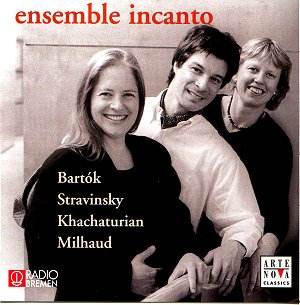Bela BARTOK
Contrasts (1938)
Igor STRAVINSKY
L'Histoire du Soldat, Suite
(1919)
Aram KHACHATURIAN
Trio (1932)
Darius MILHAUD
Suite
(1936)
 ensemble incanto
ensemble incanto
 Arte Nova Classics
74321 72105 2 [61.03] Recorded
1997
Arte Nova Classics
74321 72105 2 [61.03] Recorded
1997
Crotchet
Bargain price

These four trios for violin, clarinet and piano were all written between
the wars and are all in the then popular neo-classical style. Each has to
some extent been influenced by National folk idioms, each is also very
characteristic of it's respective composer and they are all very different
from each other in style.
The Milhaud Suite is derived from his incidental music for Jean Anouilh's
'Le Voyageur sans Bagages', it was written in one day and makes perfect use
of all three instruments. It is a very tuneful work which has led to a well
deserved popularity; it includes quotations of South American Dances. Right
from the start this ensemble demonstrates exceptional brilliance of playing
and master of complex rhythms.
'Contrasts' was commissioned by the jazz clarinettist Benny Goodman. The
three movement piece was written for Goodman and the violinist Joseph Szigeti
and Bartok played the piano part in the premier. The piece is a fascinating
mixture of fragments of Hungarian folk music interwoven with jazz and blues
influenced material. Like much of Bartok it is music which becomes more and
more interesting with repeated hearings. It must be incredibly difficult
to play, but the performance on this recording cannot be faulted.
The 'L'Histoire du Soldat' will be more familiar to most of us than the other
pieces presented here. The original piece was written for a small chamber
ensemble which included a trumpet and drums; these instruments tend to define
the work and their absence is the first impression on hearing this Suite.
The Suite was dedicated to Werner Reinholt who had provided financial support
to Stravinsky and who was also a clarinettist. Typically Stravinsky achieves
a very transparent texture for this music which combines a neo-classical
treatment of material based on popular dance styles.
There is a tendency to patronise the music of Khachaturian. This I believe
is most unfair as although his Symphonies are rather over-cooked, much of
his music is tuneful and skilfully presented. He is one of the very few composers
of the latter part of the last century to become genuinely popular with people
of ordinary musical taste; I well remember a time when his 'Sabre Dance'
was genuinely top of the pops. This trio is one of his earlier works and
is saturated with Armenian folk music presented in a most interesting and
appealing way.
I found this to be a most interesting CD with fascinating music played with
zest, intensity and enthusiasm in good recording. Fully recommended.
Arthur Baker

